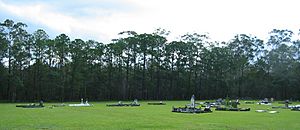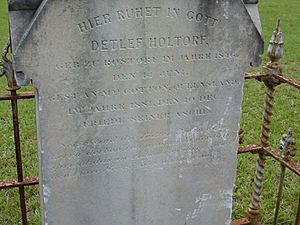Carbrook Lutheran Cemetery facts for kids
Quick facts for kids Carbrook Lutheran Cemetery |
|
|---|---|

Carbrook Lutheran Cemetery, 2005
|
|
| Location | Mount Cotton Road, Carbrook, City of Logan, Queensland, Australia |
| Design period | 1870s - 1890s (late 19th century) |
| Built | c. 1875 - |
| Official name: Carbrook Lutheran Cemetery, St Paul's Lutheran Church | |
| Type | state heritage (built) |
| Designated | 4 August 1997 |
| Reference no. | 601660 |
| Significant period | c. 1875 -ongoing (fabric, use). 1875-1951 (Church) |
| Significant components | trees/plantings, headstone, burial/grave, grave marker, memorial/monument |
| Lua error in Module:Location_map at line 420: attempt to index field 'wikibase' (a nil value). | |
The Carbrook Lutheran Cemetery is a special place in Carbrook, Australia. It is a cemetery that has been around since about 1875. This cemetery is also known as St Paul's Lutheran Church. It is considered a heritage site, meaning it's important to history. It was added to the Queensland Heritage Register on August 4, 1997.
Contents
A Look Back: The History of Carbrook Cemetery
The story of Carbrook Lutheran Cemetery begins with early settlers in the Logan area of Queensland. In 1861, land became available for people to buy or choose. This led to many new families moving to the area.
Who Were the First Settlers?
A large group of 22 families came from north-eastern Germany between 1863 and 1864. They settled in a place now called Bethania. These families were mostly farmers. They came to Queensland with help from the Lutheran Church in Germany and Johann Christian Heussler. Heussler was an agent for the Queensland Government.
These German families were very close-knit and self-sufficient. This helped their settlement become successful. Many people in Europe, especially tenant farmers, dreamed of owning their own land. Queensland offered land to those who paid their own way. This, along with problems in Prussia (part of Germany), encouraged many families to move.
How Gramzow Village Started
One of these families was Hermann Meisenner's. He applied for land in the Logan area in 1868. Soon, other families followed. Their new settlement was named Gramzow. This name came from a small village in Germany called Gramzow. Many of the settlers came from that area.
These settlers brought their culture and their Lutheran faith with them to Queensland. At first, families from Gramzow and a nearby settlement at Mount Cotton went to a church far away. But the journey was too long.
Building St Paul's Church and Cemetery
So, in 1875, the two communities decided to build their own church. Pastor Haussmann bought ten acres of land. This land was located between Gramzow and Mount Cotton. Three acres were cleared to build a church and a cemetery.
A group of people helped plan the church. By 1876, the Church of St Paul was finished. It cost about £130, which was a lot of money back then! Most of the money was raised by people giving donations. The church was built by community members. It was made in a traditional German style, using hand-made bricks and timber frames. This original church was taken down in 1951. A new church was built on land at Mount Cotton.
The cemetery, which was next to the old church, is still used today. It holds the graves of many of the first settlers and important people from the Gramzow and Mount Cotton areas.
Carbrook's Name Change
In 1916, during World War I, feelings against Germany were strong. Because of this, the Gramzow area was renamed Carbrook. Besides the cemetery, other old buildings from that time still exist. These include the Old Carbrook State School and Kruger's Fachwerk Farmhouse.
What Does Carbrook Cemetery Look Like?
The cemetery is located at the corner of Mount Cotton Road and Wuduru Road. A double row of tall pine trees surrounds the entire area. These trees were planted in the 1960s. There are no other large plants within the cemetery itself.
The graves are mostly on the western side of the land. This area was originally behind the church. There are more than one hundred marked graves today. However, some of the very first graves no longer have markers. The oldest grave that can still be identified belongs to Detlef Holtorf, who passed away in 1881.
German Language on Headstones
Many of the graves belong to the first German settlers and their families. A lot of the older headstones have writing in German. This is because German was the language used in St Paul's church services until 1924. Most inscriptions are in standard German. However, one grave, the Scheer grave, has an inscription in "Platt Deutsch." This is a special German dialect that was spoken at home but rarely written down.
Grave Layout and Markers
The graves are set up in clear family sections. In the past, each family plot had a neat fence around it. This might have been to keep animals away and to show respect for the graves. But, probably in the 1980s, these fences and metal markers were removed. This made it easier to mow the grass with machines. You can still see the holes where the fences used to be.
Most of the grave markers are simple, upright stone slabs. One grave, belonging to Lizzie Benfer, has a beautiful carving of an angel on top. Some headstones have long texts or poems written on them. Newer graves are marked with small, simple metal plates.
There is one grave on the very edge of the cemetery, outside the line of trees. It belongs to Walter Costin, who passed away in 1919.
Why is This Cemetery Important?
The Carbrook Lutheran Cemetery is listed on the Queensland Heritage Register. This means it is important for several reasons:
Showing Queensland's History
The cemetery, which started in 1875, helps us understand the history of Carbrook. It also shows how the population of the area changed over time.
Learning About Early Settlers
This site can give us information about the German settlers who came to the Logan district. They were a small but very strong group who played a big part in settling the area.
Its Special Look and Feel
The cemetery has a special beauty because of how the family plots are arranged in a rural setting. The use of "Platt Deutsch" on some headstones is also very unusual and adds to its unique character.
Connection to a Community
The cemetery has a strong link to the Carbrook community. It is especially connected to the German Lutheran Church. This church worked with John Heussler to help the first German pioneers move to Queensland. The fact that a German community has been in the area since the 1860s is also very important.
Images for kids





